SAMOA
Paintings by
Norbert H. Kox
2014
U.S. Artist in Residence
National University of Samoa
Apocalypse House
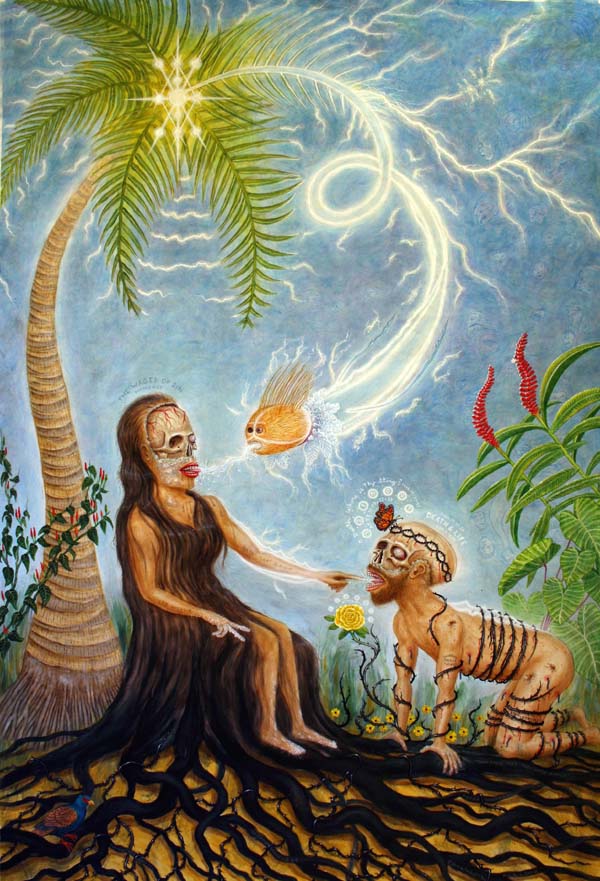
(acrylic on canvas, 68-in high x 45-in wide)
In The Garden
More about the blood rescue:
"Grace to you and peace from God the Father and Lord of us, Yesu Christ, Who gave himself for our sins, that he might deliver us from this present evil world, according to the will of God and our Father" (Galatians 1:3-4).
As a spirit, God could neither bleed nor die. That is why it was necessary for him to manifest in human form as Yesu Christ to redeem his creation.
Speaking to the elders of the church, Paul said, "Take heed therefore unto yourselves, and to all the flock, over the which the Holy Ghost hath made you overseers, to feed the church of God, which he hath purchased with his own blood." (Acts 20:28). This tells us that the blood of Yesu Christ is God's own blood. God became man to provide the blood of redemption (man=adam: "I will bleed").
“...By one man sin entered into the world, and death by sin; and so death passed upon all men...
“...if by one man's offence death reigned by one; much more they which receive abundance of grace and of the gift of righteousness shall reign in life by one, Yesu Christ.
“...so by the obedience of one shall many be made righteous.
“...That as sin hath reigned unto death, even so might grace reign through righteousness unto eternal life by Yesu Christ our Yahweh.” (Romans 5:12-21)
It was all planned and purposed before the world began. The grace by which he has called us was set in place before time brought us into existence.
"...be thou partaker of the afflictions of the gospel according to the power of God; Who hath saved us, and called us with an holy calling, not according to our works, but according to his own purpose and grace, which was given us in Christ Yesu before the world began, But is now made manifest by the appearing of our Saviour Yesu Christ, who hath abolished death, and hath brought life and immortality to light through the gospel" (2Timothy 1:8b-10).
The gospel is death, burial and resurrection: "...I declare unto you the gospel which I preached unto you, which also ye have received, and wherein ye stand; By which also ye are saved... For I delivered unto you first of all that which I also received, how that Christ died for our sins according to the scriptures; and that he was buried, and that he rose again the third day according to the scriptures" (1Corrinthians 15:1-4).
As Christ died was buried and resurrected, we have the opportunity and privilege to symbolically follow in repentance (death to sin and the old man), water baptism/immersion (burial), and infilling of the Holy Spirit (resurrection/newness of life).
Romans 6:
3. Know ye not, that so many of us as were baptized into Yesu Christ were baptized into his death?
4. Therefore we are buried with him by baptism into death: that like as Christ was raised up from the dead by the glory of the Father, even so we also should walk in newness of life.
5. For if we have been planted together in the likeness of his death, we shall be also in the likeness of his resurrection:
6. Knowing this, that our old man is crucified with him, that the body of sin might be destroyed, that henceforth we should not serve sin.
7. For he that is dead is freed from sin.
8. Now if we be dead with Christ, we believe that we shall also live with him:
9. Knowing that Christ being raised from the dead dieth no more; death hath no more dominion over him.
10. For in that he died, he died unto sin once: but in that he liveth, he liveth unto God.
11. Likewise reckon ye also yourselves to be dead indeed unto sin, but alive unto God through Yesu Christ our Yahweh.
12. Let not sin therefore reign in your mortal body, that ye should obey it in the lusts thereof.
13. Neither yield ye your members as instruments of unrighteousness unto sin: but yield yourselves unto God, as those that are alive from the dead, and your members as instruments of righteousness unto God.
14. For sin shall not have dominion over you: for ye are not under the law, but under grace.
15. What then? shall we sin, because we are not under the law, but under grace? God forbid.
16. Know ye not, that to whom ye yield yourselves servants to obey, his servants ye are to whom ye obey; whether of sin unto death, or of obedience unto rghteousness?
This painting titled In The Garden (acrylic on canvas, 68" x 45") is based on the fall of man. It was completed by Norbert H. Kox, at Tiapapata, Samoa, during the two months following his Artist in Residence with the National University of Samoa at Apia.
If you are interested in either of these pieces,
IN THE GARDEN or BREAD OF HEAVEN
please contact
Cavin-Morris Gallery
210 11th Ave, rm 201, New York, NY 10001
Telephone (212) 226-3768.
In The Garden is filled with references to Samoa and Samoan culture. Immediately noticeable is the electric eel twirling down from the coconut tree. In one of the many Polynesian tales of Sina and the Eel, a beautiful young girl had a pet eel that fell in love with her and followed her everywhere. She cried "You stare at me, with eyes like a demon!" At this the village chiefs killed it and Sina buried its head in the ground, from which a coconut tree sprouted forth. The coconut has a face like the eel so when Sina would drink from it she was kissing the eel (Wikipedia: "Sina and the Eel").
In Samoan culture the coconut tree is called The Tree of Life, because it supplies all the essentials they need to live, for food, water, shelter, baskets, rope and many other necessities. Here it represents the tree in the middle of the garden (Genesis 2 & 3) the tree of life and of good and evil knowledge. The demon eel is representative of the tempter serpent in Eden.
In the painting we see the deceiving serpent emerging from the Tiferet portal with passage references written on his fins (2Corinthians 11:14-15; 2Thessalonians 2:9-11): Satan disguises as an angel of light, and the mystery of iniquity is after the working (Greek, energia: energy) of Satan. This is telling us that not all energy coming from the spiritual realm is good. Evil or bad energy is also coming through, so we must be cautious and pray for discernment of spirits that we be not deceived.
The coconut-headed serpent is missing his right eye and on his forehead, 11:17 Zech, is written. Zechariah 11:17 reveals that the idol shepherd (the antichrist) has his right eye darkened. To have the right eye darkened is a scriptural analogy of spiritual blindness. In keeping with the theme, the right eyes of Adam and Eve are also missing after the fall.
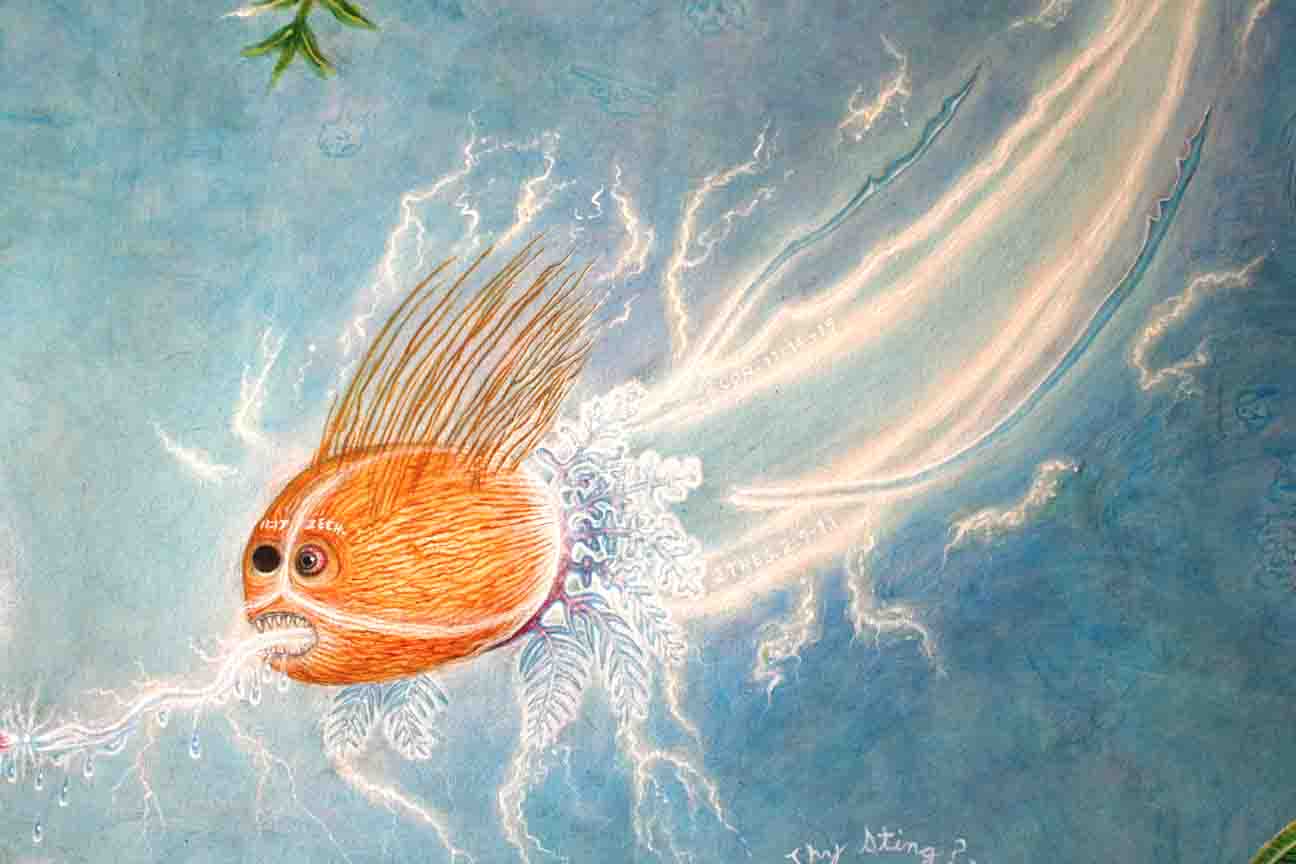
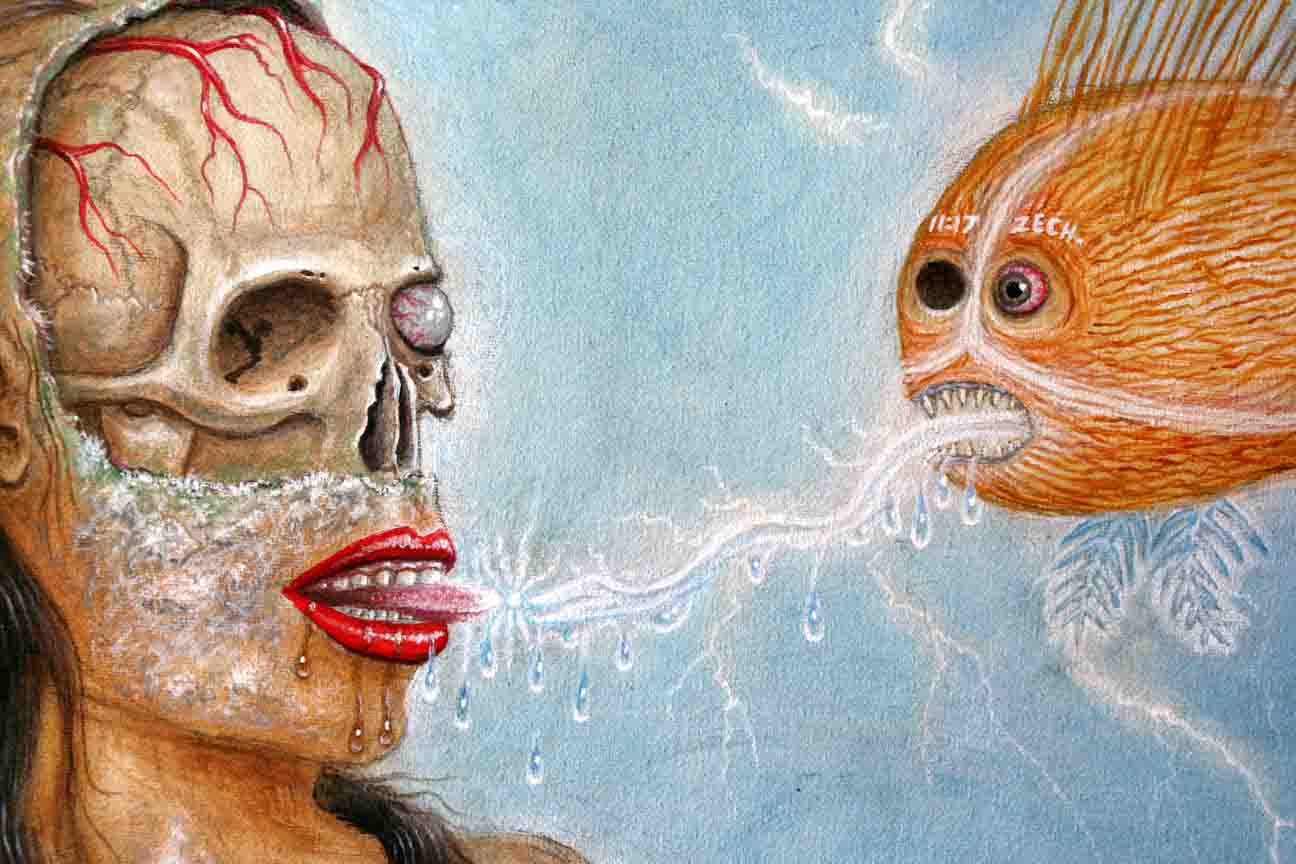
The drooling tongue of this snake devil is passing his bad energy to Eve on the tip of her tongue. As she kisses the eel its energy runs through her and down her left arm (where we see engraved, GEN. 3:5 "I AM" IS. 14:12-14. The serpent tempted Eve in Genesis 3:5, with these luring words, "Ye shall be as gods." And in Isaiah 14:12-14, he boasted, "I shall be like the Most High." The phrase "I AM" is one of God's titles and when someone says I AM they are claiming to be God).
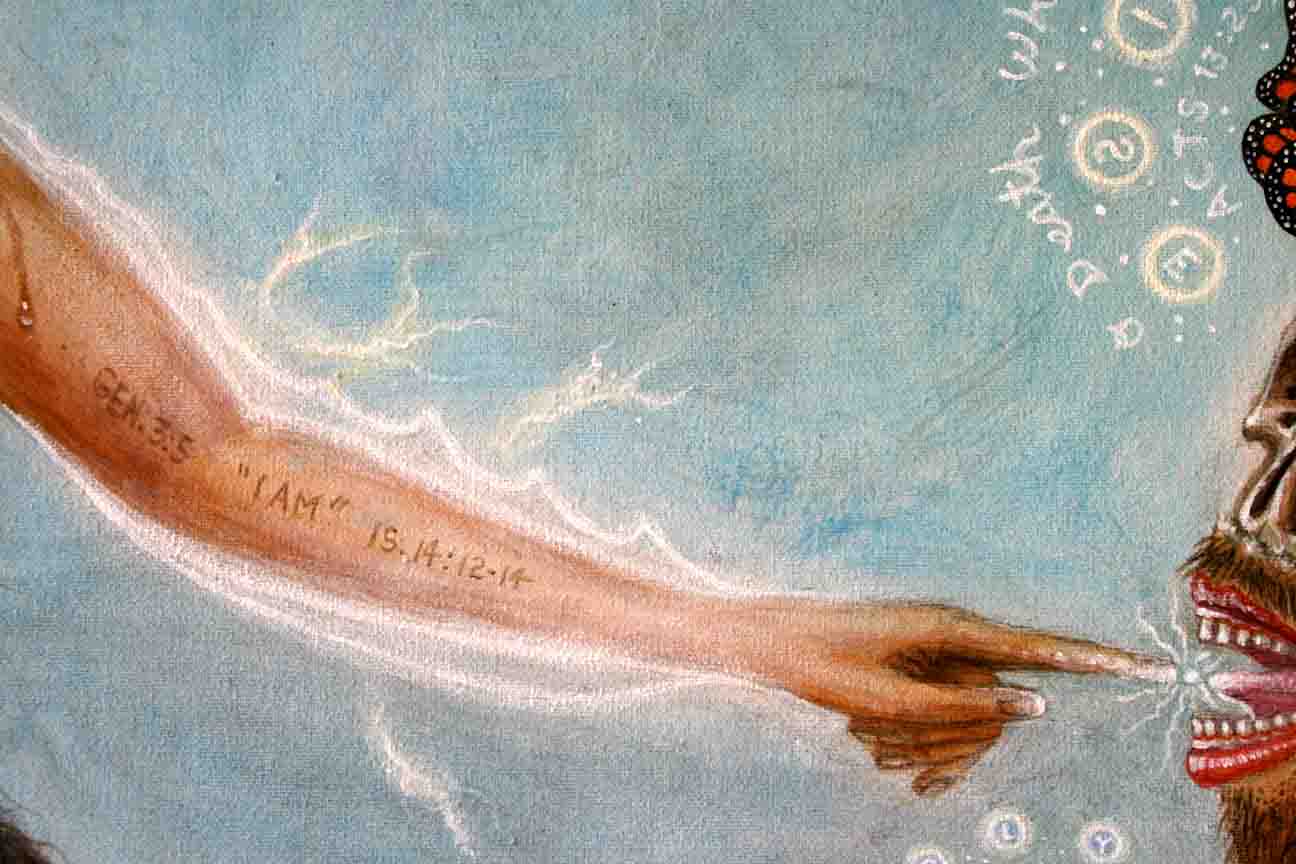
Genesis 3:5, says, "...in the day ye eat thereof, then your eyes shall be opened, and ye shall be as gods..." So the temptation was more than just to see what this forbidden fruit was like, but involved an element of pride: If I partake of this I can be just like God. Isaiah !4:14, is the satanic statement, "I will ascend above the heights of the clouds; I will be like the most High." Eve's response, "I AM," are the words of a boastful antichrist. When someone says, I AM, death and destruction will follow, e.g. Isaiah 47: 7-9; Ezekiel 28: 2-10; and Zephaniah 2: 15.
From the tip of Eve's finger the bad energy that flows from the serpent is conducted to Adam's tongue rendering him susceptible to death.
In Michelangelo's Vatican ceiling fresco, "The Creation of Adam," Adam's left forefinger receives the touch of God, while here we see Eve's left forefinger conveying the touch of sin. Above Eve's head is the phrase, "The wages of sin," referenced from Romans 6:23, where it says those wages are death.
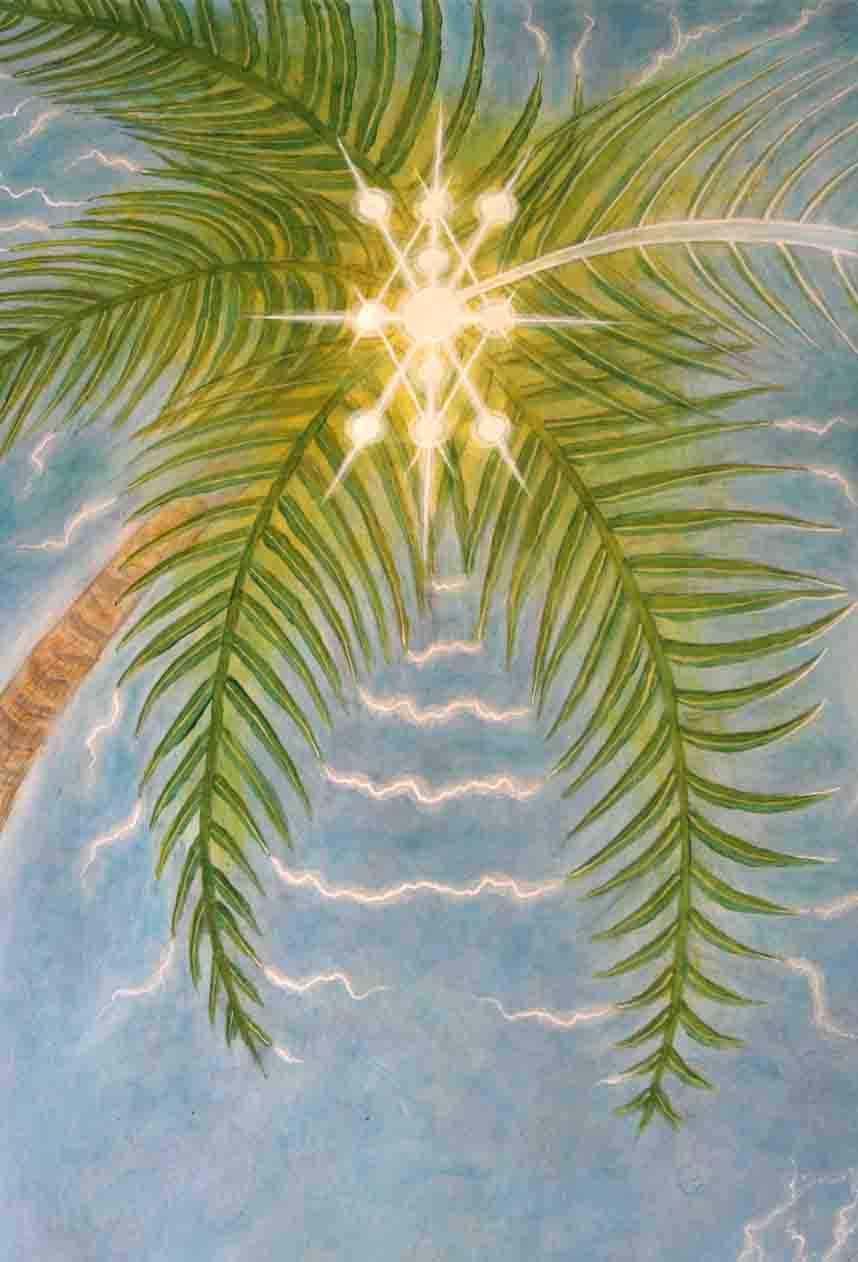
Beneath the pattern of spheres, in the tree, we see electrical impulses sparking between the palm fronds, like Jacobs Ladder or stairway to heaven. This is another symbolic reference to the portal of heaven or entryway between the physical and spiritual realms.
A symbol of quintessence, or the fifth element, is present in the tree of life. Nine is the number of divine manifestation. The energy lines between the nine primary spheres in the tree of life pattern form two stacked tiers of double X's. Two side-by-side X's are standing on top of two more. The four X's in that configuration create a fifth X at the center of a diamond shape, which is made up of four smaller diamonds. The four X's and four diamonds represent the four elements, earth, fire, water, air, while the fifth X and the fifth diamond represent the fifth element (quintessence) the ether that comprises the spiritual realm of light and energy. The fifth element symbol is centered on the sephirot or sphere named Tiferet, which is at the exact middle of the tree and connects all the other spheres. It also represents a portal between the heavenly and earthly domains. Tiferet means adornment, beauty and glory. It is the sixth sphere and corresponds to the Hebrew letter waw (or, vav) which is another portal symbol linking heaven and earth.
The world we now see was first created of pure energy. According to ancient writings Adam and Eve were made of energy. They were beings of light. After the fall God made them coats of skins (Genesis 3:21). In the Hebrew text it is written in the singular, “skin.” It is probably not referring to coats sewn together of animal skins, since skin is singular. It may be a reference to beings of light receiving actual skin in the physical realm. Yahweh apparently slowed down their frequencies so that they manifested as flesh and blood physical beings. Energy became matter. Einstein once said, “What we have called matter is energy, whose vibration has been so lowered as to be perceptible to the senses.”
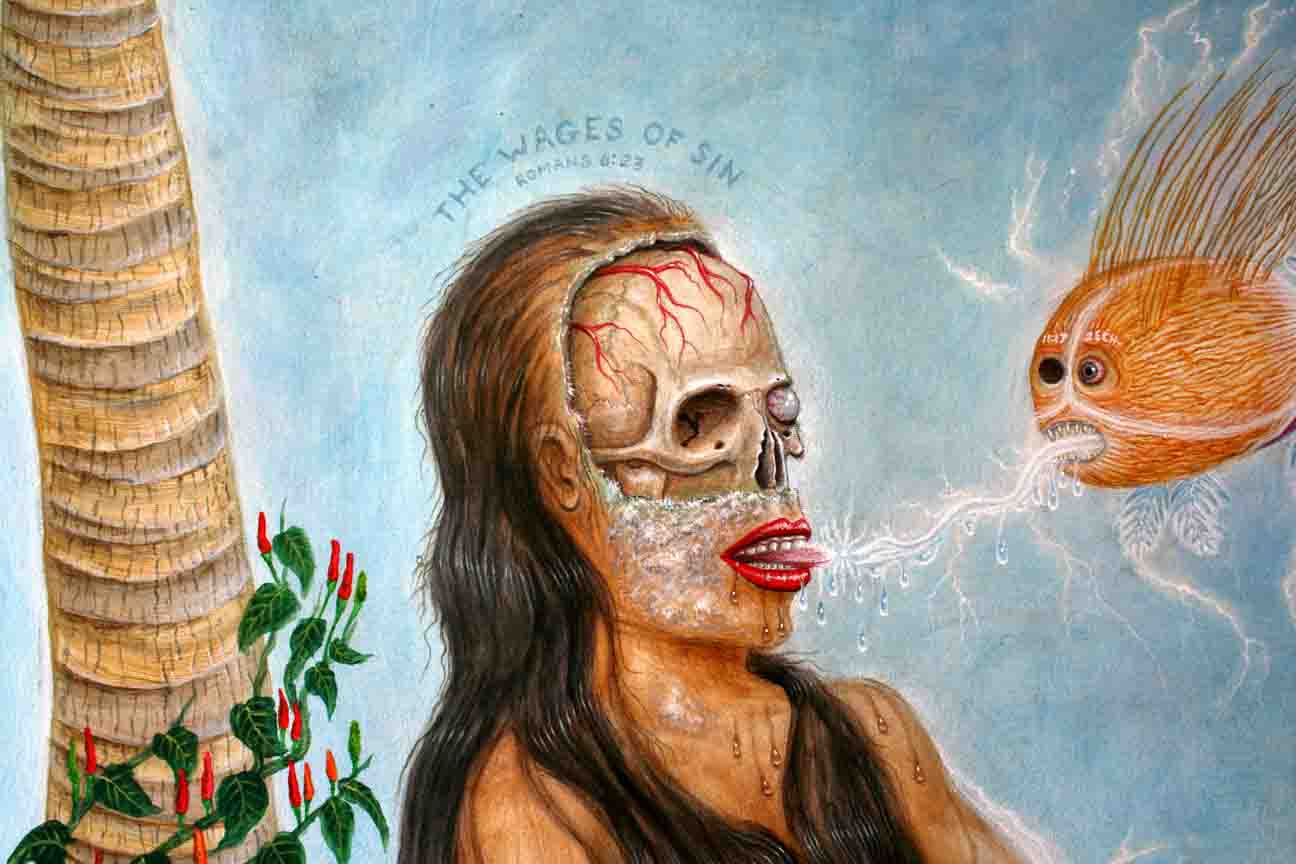
Above Eve's head is the phrase, "The wages of sin," referenced from Romans 6:23, where it says those wages are death: "For the wages of sin is death; but the gift of God is eternal life through Yesu Christ our Yahweh."
Adam's and Eve's faces appear to have decomposed from leprosy, symbolizing death. Leprosy is a Biblical analogy for sin because of its capability to bring a slow death. It affects the nerves and destroys the pain receptors rendering the victim incapable of feeling pain. Because those infected feel no pain, they may receive serious injuries without even knowing it. They do not realize they are injured so they do not seek help. As a result they often lose limbs due to infections.
It is also an analogy of sinners, “having their conscience seared with a hot iron.” (1Timothy 4:1-2). That is the description of cauterization. When a wound is cauterized the blood vessels are sealed to stop the blood flow. When a conscience is cauterized it stops the flow of conscience. A person no longer feels conviction for wrong-doing. Now they are like a leper walking on broken glass and nails without feeling pain. It brings about a slow death without the victim feeling a thing.
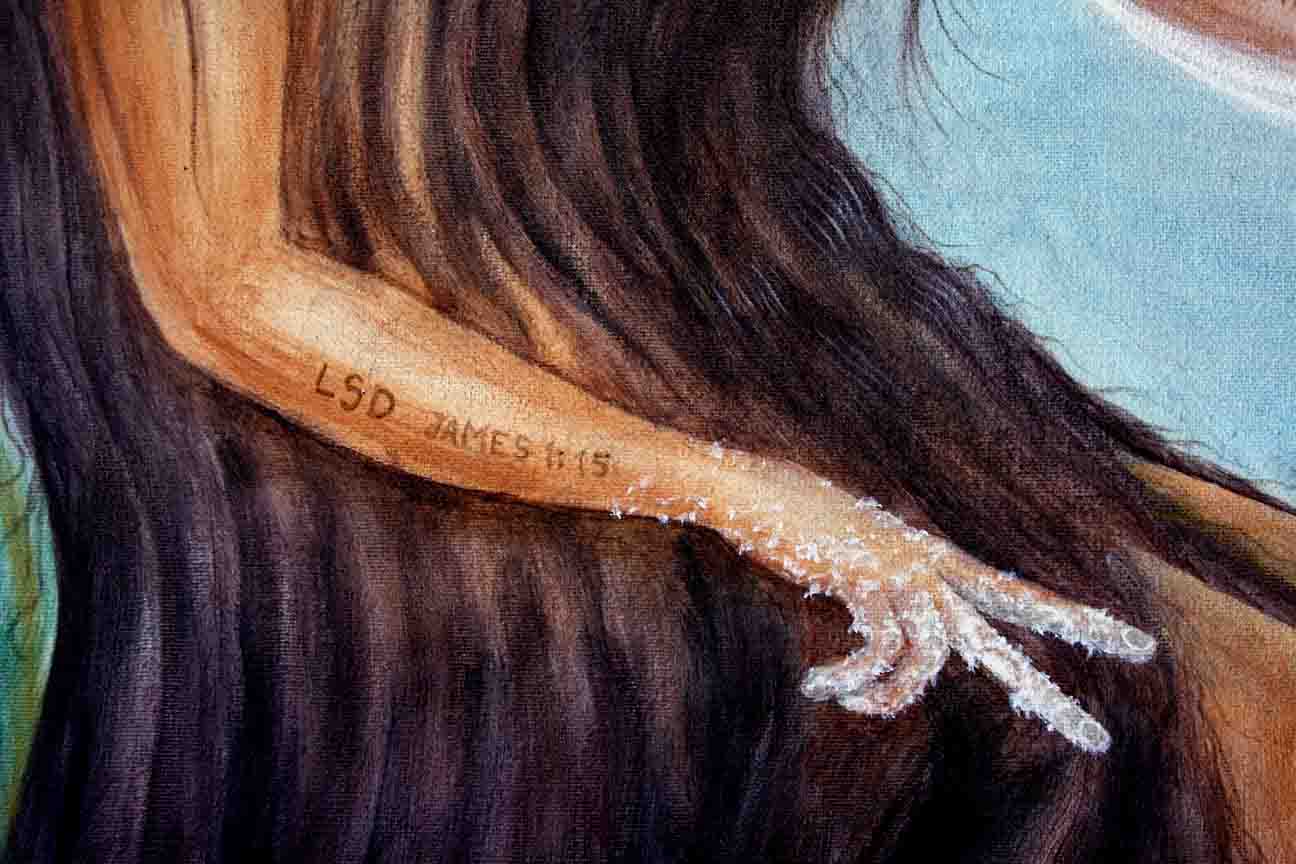
On Eve's right arm is inscribed, LSD JAMES 1:15. The LSD represents lust, sin, and death: "Then when lust hath conceived, it bringeth forth sin: and sin, when it is finished, bringeth forth death." Already her fingers are rotting to the bone with leprosy.
The energy pattern painted into the palm fronds represents the image of God in which man was created. The energy spheres (sepihrot) also represent the tree of life. This symbolic image of God, the tree/plan of life and the blueprint of man, first came into my paintings in the winter of 2005-2006, and has appeared in many paintings since.
This energy pattern is imprinted on/in every human being. It is the Divine System of Spontaneous Regeneration responsible for energy coming into and flowing out of each person and determining our physical, mental and spiritual health. This pattern can be affected by our attitudes, thoughts and actions in either a positive or negative way
Close examination of the blue background of the painting reveals an array of strange looking heads which are probably evil spirits that came through the portal with the serpent to deceive mankind.
On the right side of the painting is the National flower of Samoa, the Teuila or red ginger, and below it is the Taro plant, which is one of the food staples of Samoa. The root is baked on an open fire and the leaves are used with rice and coconut milk to make a desirable dish called palusami. The root is then broken and dipped into the palusami and eaten. Delicious!
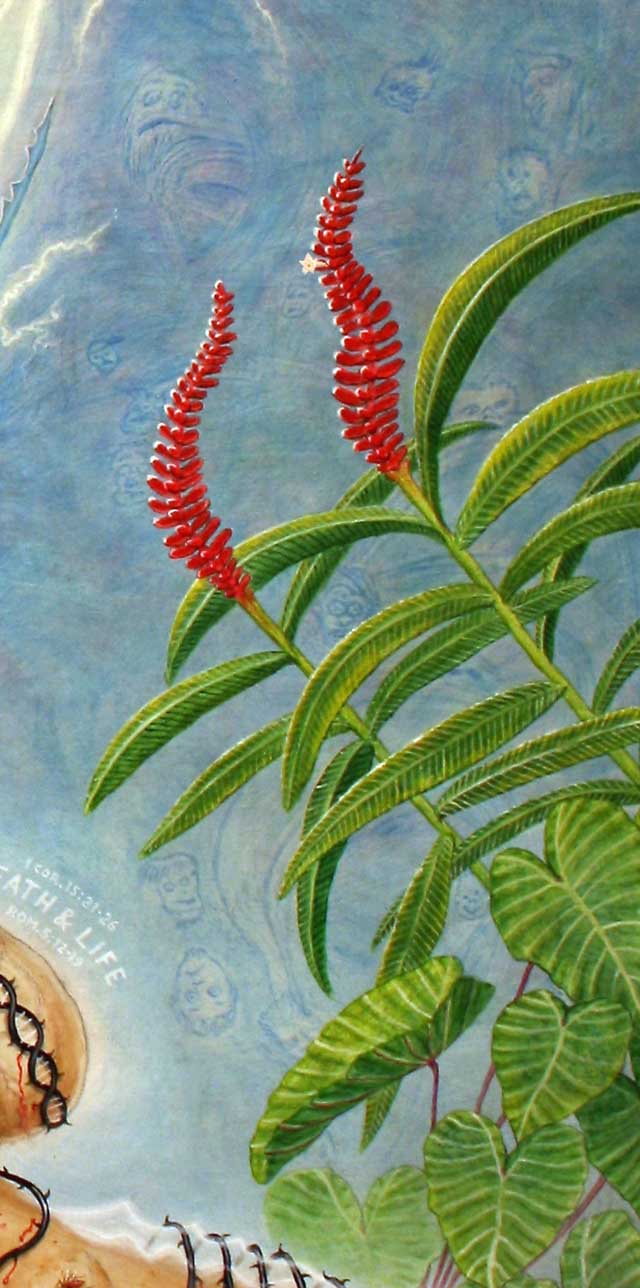
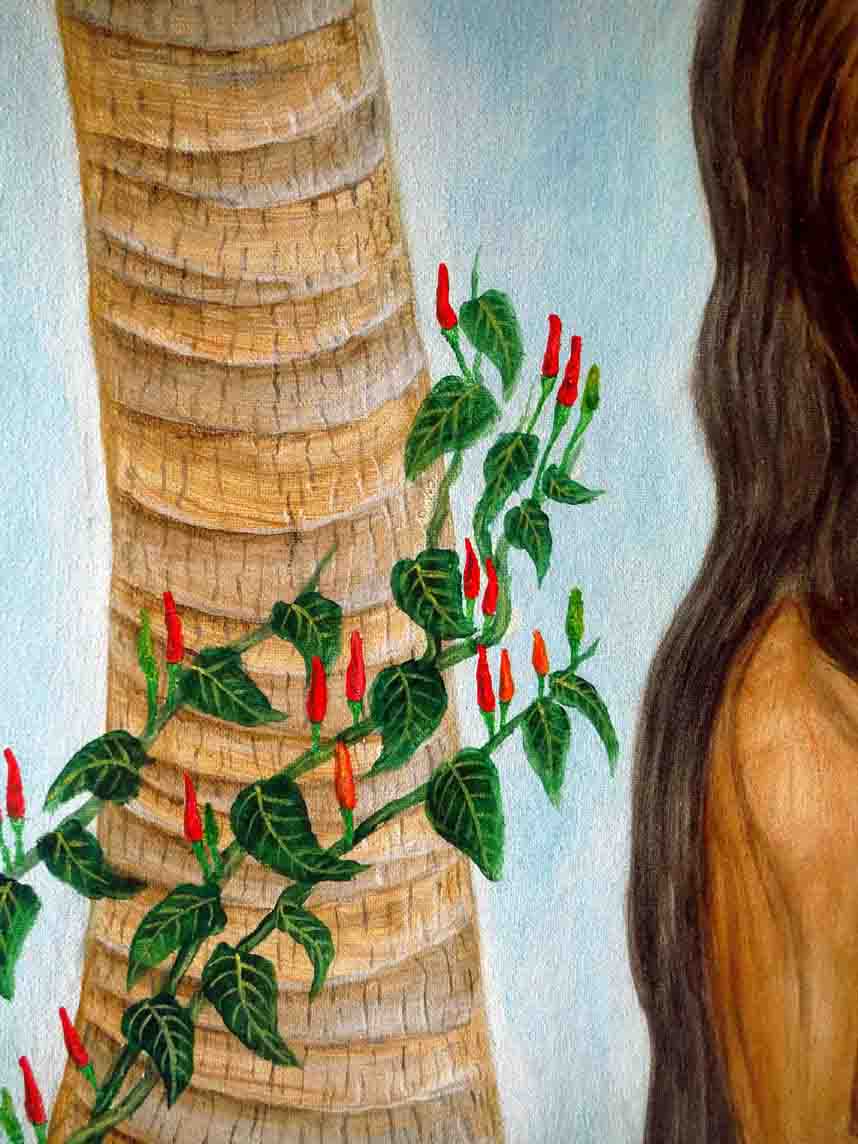
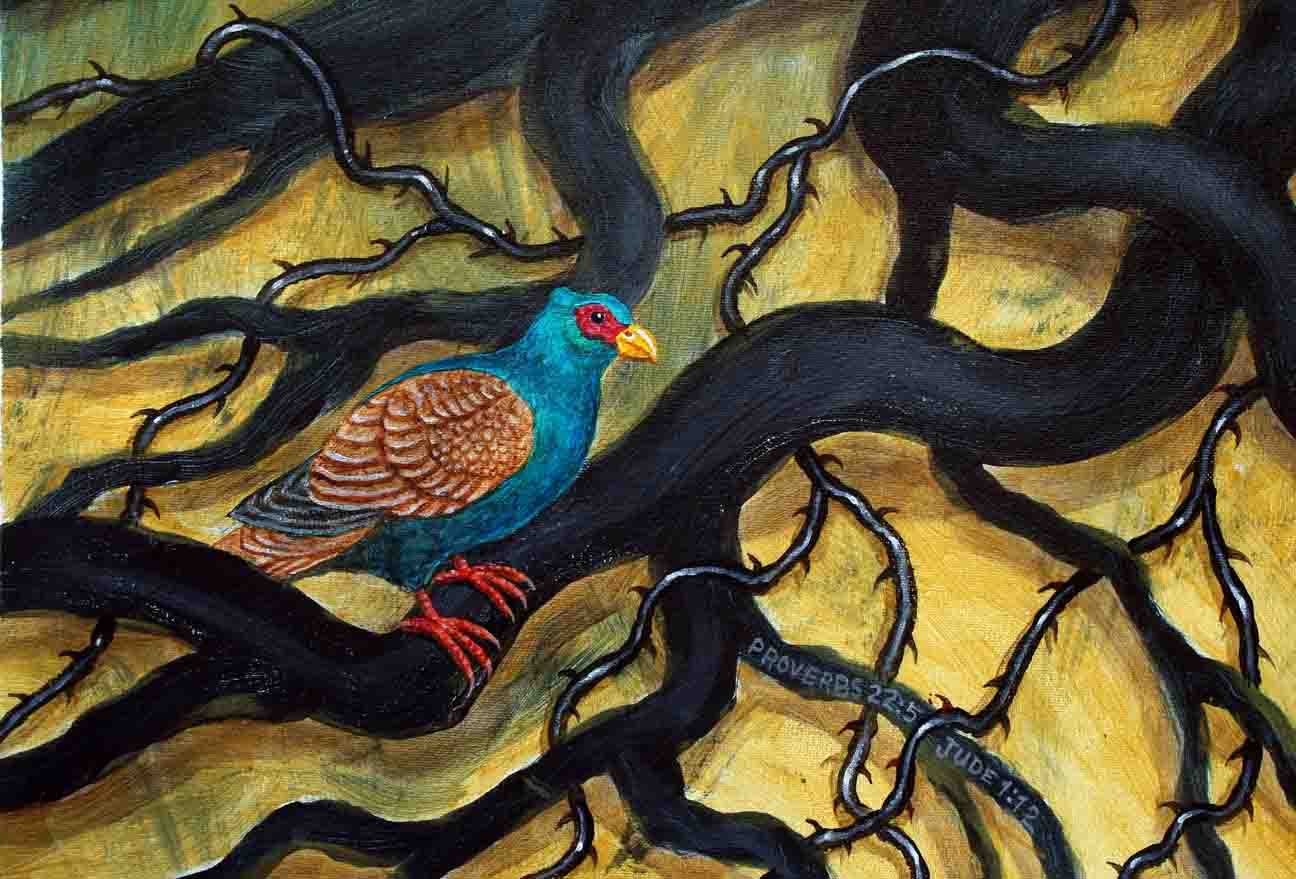
...behind Eve is the famous Samoan hot chili pepper tree, which sometimes grows to be over twelve feet tall (I saw it with my own eyes) and produces a delicious chili pepper that is hot enough to delight any chili connoisseur.
Perched upon the roots in the lower left corner is Samoa's National bird, the very rare manumea, or tooth-billed pigeon...
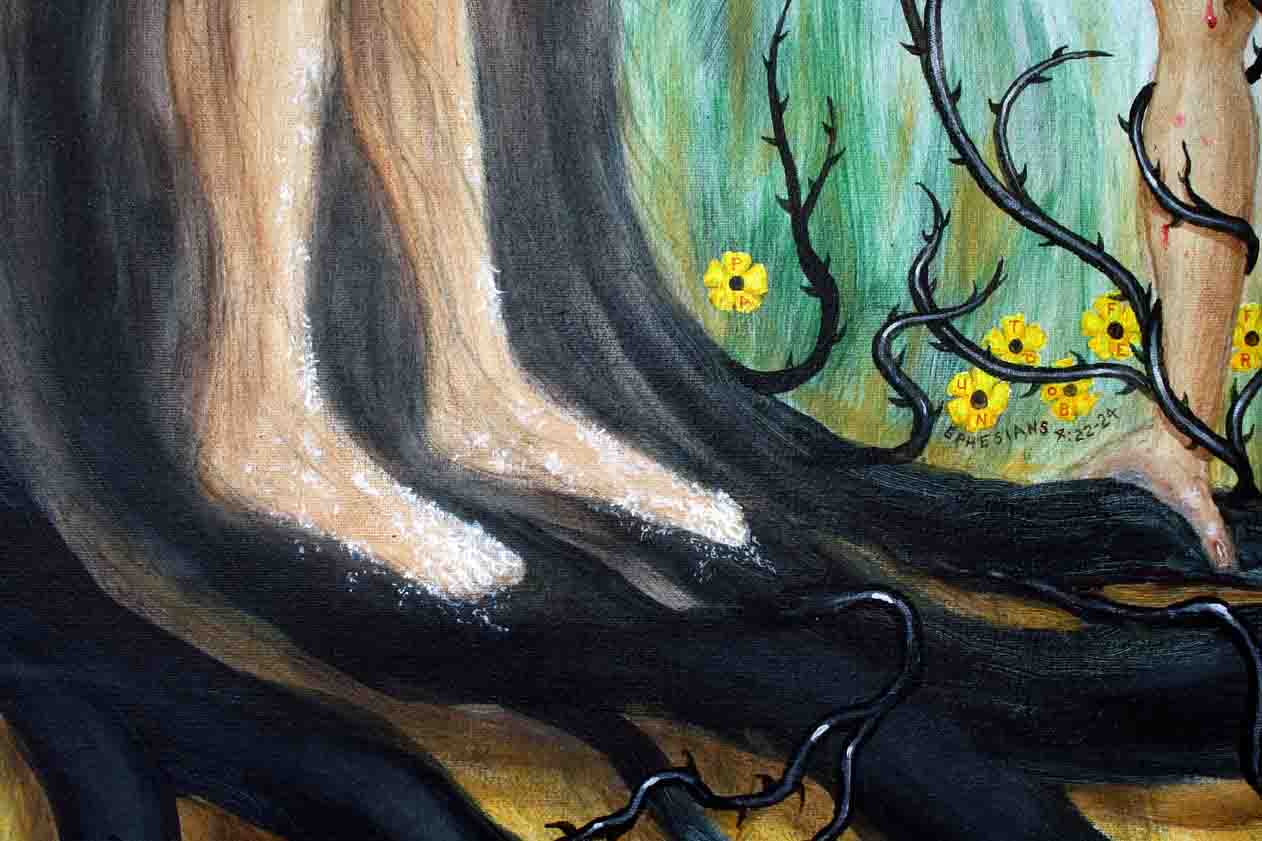
The roots below Eve's feet have sprouted from her once beautiful hair and now lie hopelessly on top of the dry ground. Plucked up roots are a Biblical analogy to the wicked. Just as a plant dies when its roots are plucked from the earth, when a person is cut off from God they too whither and dry up spiritually. Scattered among the roots are passage references attesting to this fact. On the roots nearest the manumea bird, Proverbs 22:5 / Jude 1:12; near center, Isaiah 5:24 / Hebrews 6:8; and far right, beneath Adam, Luke 8:14 / 1Timothy 6:10. In the painting these are citation references only, without the quotations. It is done this way so that the a viewer who is interested enough will be enticed to open a Bible and look up the passages, and perhaps read a little before and after, possibly feeling the excitement of actual Bible research
Eve's feet are turning to a grey flaky dust powder as leprosy consumes her (symbolizing the death process, as dust returns to dust).
In the painting, Adam's and Eve's faces have decomposed of leprosy, symbolizing the entrance of death into the world (leprosy is a Biblical analogy for sin). Their disobedience initiated death, but they were promised a redeemer who would buy back life for them and for us. God has created past, present and future simultaneously and given us time as a means of ageing and death. Before he ever put the world into motion he had already seen the disobedience of mankind that would start the death process, so he sacrificed himself in human form to abolish death and return to us immortality in a resurrected glorified body, that we should be like him. (We are made in his image.)
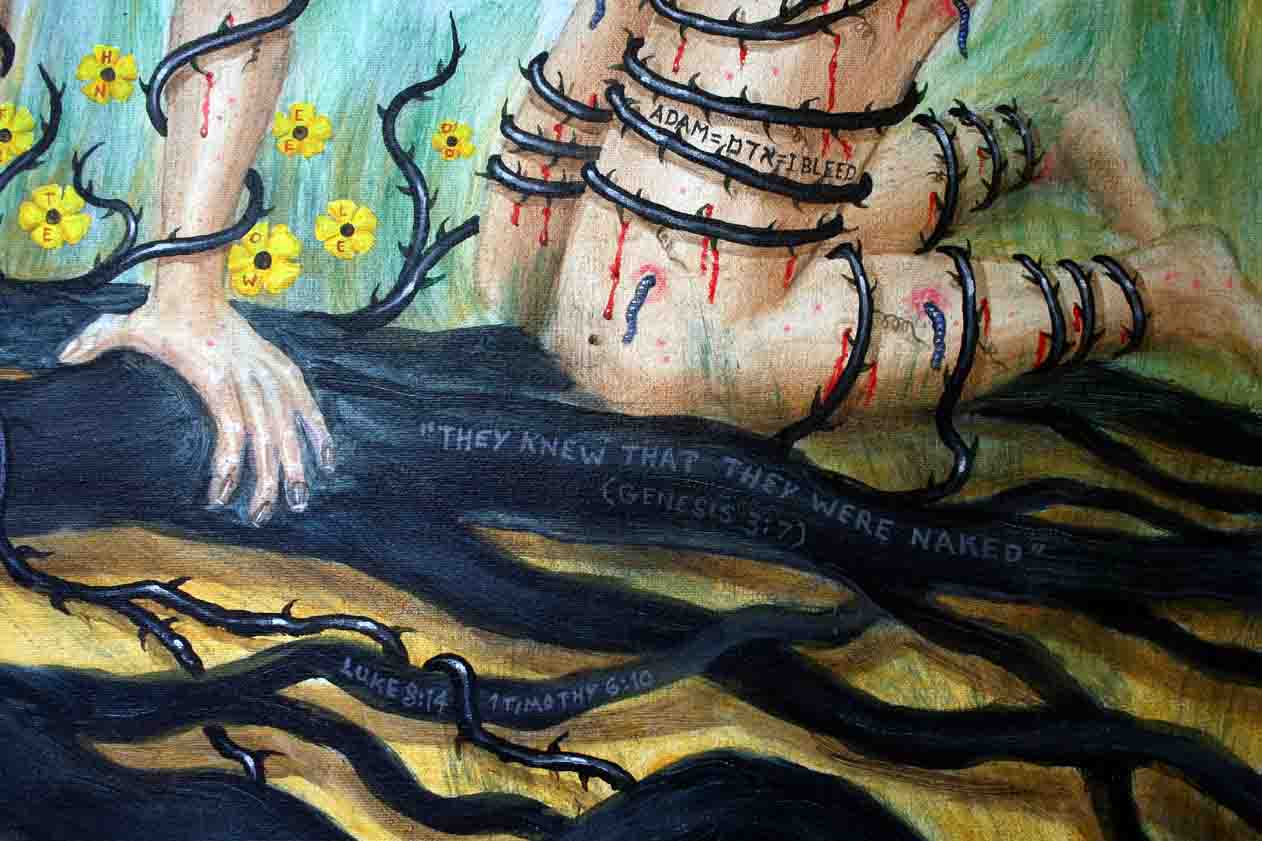
Beneath Adam's knees are the words, "They knew that they were naked" (Genesis 3:7). When they were innocent they knew no wrong. They had only one commandment, Eat not of the tree in the middle of the garden. When they disobeyed, their conscience kicked in and they knew right from wrong. They had jump-started the process of death. Both were equally guilty and both were punished. Perhaps you may say they did not die in the day that they ate. But they did. Scripture says, "one day with Yahweh is as a thousand years" (2Peter 3:8, Greek, about or almost 1000, i.e. 999 years; cf. Psalm 90:4). Adam died at 930 years, in that day. Methuselah, son of Enoch, lived 969 years and was the oldest man in the Bible. No man has ever lived beyond 999 years, one day of God's time. "In the day that thou eatest thereof thou shalt surely die.” (Genesis 2:17; cf. 3:3).
The writing on Adam's leg says, "I bleed," translated from his name.
In Scripture we learn that Yesu is the second Adam or the new Adam; it says that by the first Adam came death and by the last Adam comes life (cf. Romans 5:14; 1Corinthians 15:21-22, 45-47). The name/word Adam (sometimes translated "man") spelled out in the Hebrew characters aleph-dalet-mem produces the phrase, "I bleed," or "I will bleed." That is the literal meaning of Adam.
Before the fall there was no bleeding. When Adam and Eve moved from the kingdom of light into the physical realm of "matter" and darkness they also acquired all that goes along with being human, including the ability to bleed and to die. As mortals condemned to death for their foolish mistake, they now needed a way to enter back into the realm of light and life. God already had a plan for a redeemer who would shed his blood for the reconciliation and redemption of his creation, but they still had to die first, “It is appointed unto men once to die.” (Hebrews 9:27).
Yahweh knew from the beginning that man would fall, so according to his plan he already saw the Lamb of God that takes away the sin of the world, Yesu, sacrificed from the foundation of the world (ref. Revelation 13:8).
Yesu Christ is the creator of all things and as such he was the only one who could atone for man's sin and bring redemption and reconciliation. God had established that without the shedding of blood there is no remission (Hebrews 9:22).
The first Adam acquired the ability to bleed and die, as a curse, when he entered the physical realm (i.e. ate of the tree lives - good and bad knowledge, and was sent from light into darkness). "The wages of sin is death" (Romans 6:23). The second Adam ("I will bleed") took the curse of sin and death upon himself, becoming the curse for us, to redeem us from eternal death by shedding his own blood for us in the scourging and crucifixion. For the Scripture says, "Cursed is everyone that hangs upon a tree [cross]." He had to bleed and die under the curse of sin so that when he resurrected he would have the victory over sin and death and the ability to pass that quality on to his followers. So now when we repent, change, and commit to Yesu Christ, we have redemption of sin (not a license to sin, but a promise that we can overcome sin through the Holy Spirit) and the hope of the resurrection in a glorified body to live in his everlasting kingdom of light.
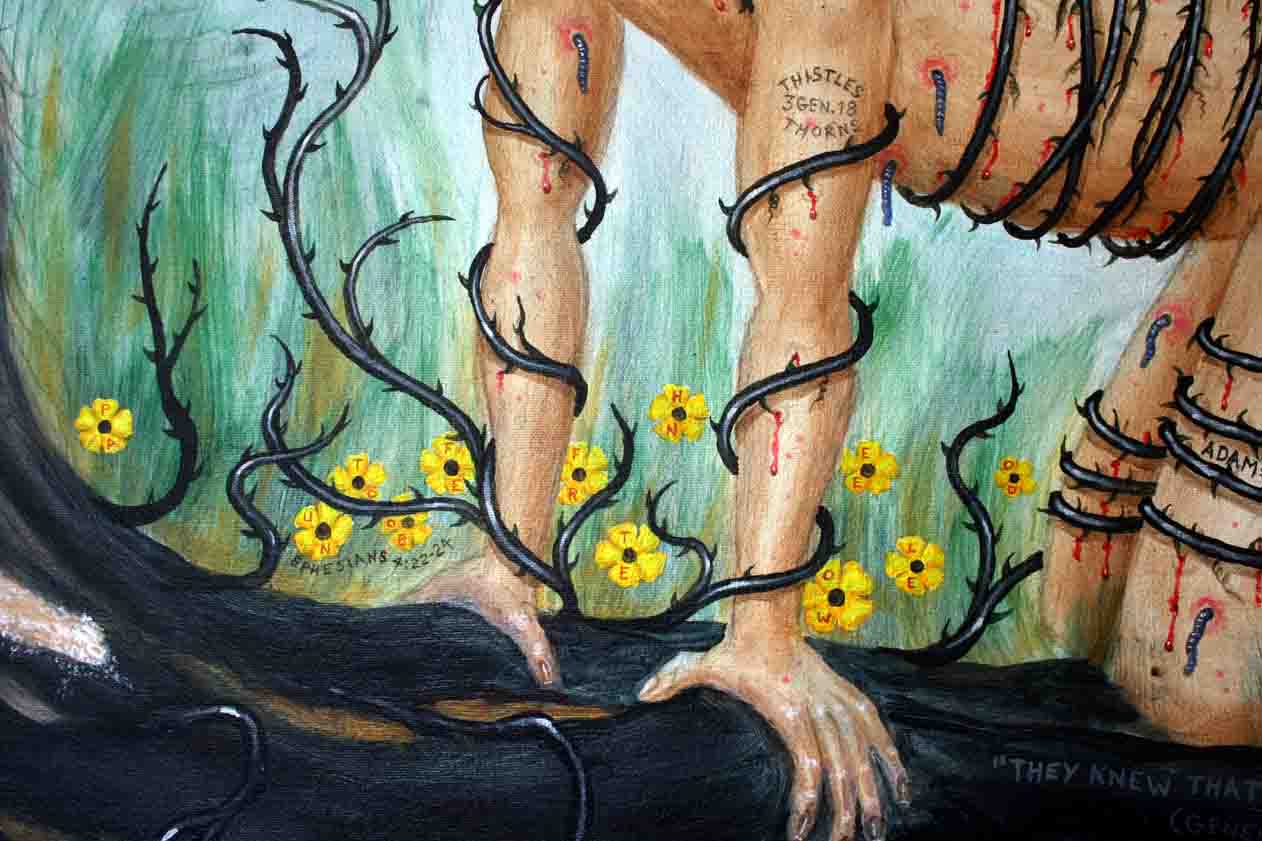
The ground (adamah) was cursed for Adam/mankind, and on his left arm in the painting we see it written, THISTLES 3GEN.18 THORNS. The vines of thorns wrapped around Adam like a coil of barbed wire are a stark symbol of the grip and bondage of sin.
There is a curse but there is also the promise: "Therefore as by the offence of one judgment came upon all men to condemnation; even so by the righteousness of one the free gift came upon all men unto justification of life. For as by one man's disobedience many were made sinners, so by the obedience of one shall many be made righteous. Moreover the law entered, that the offence might abound. But where sin abounded, grace did much more abound: That as sin hath reigned unto death, even so might grace reign through righteousness unto eternal life by Yesu Christ our Yahweh." (Romans 5:18-21).
The small yellow flowers below Adam are Black-Eyed Susan (Thunbergia alata) also called Clock Vine, found in Western Samoa and several other Islands of the South Pacific, as well as locations around the world where climate supports them. The color yellow symbolizes hope. Some of its positive aspects are that it relates to acquired knowledge and is uplifting and illuminating inspiring happiness and cheerfulness. It can also awaken and enhance confidence and optimism. Also, the flower is a symbol of resurrection and rebirth. Here they relate to Ephesians 4:22-24. The letters on the top petals spell out, PUT OFF THE OLD, and the lower petals spell, AND BE RENEWED. There are twelve flowers to represent the Twelve Apostles, but the message is for all of us.
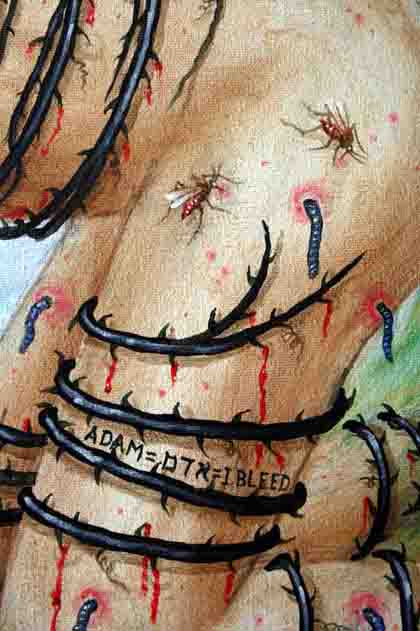
While the thorns puncture his skin causing bleeding and slow death, the leeches and giant mosquitoes help in the process of draining his life.
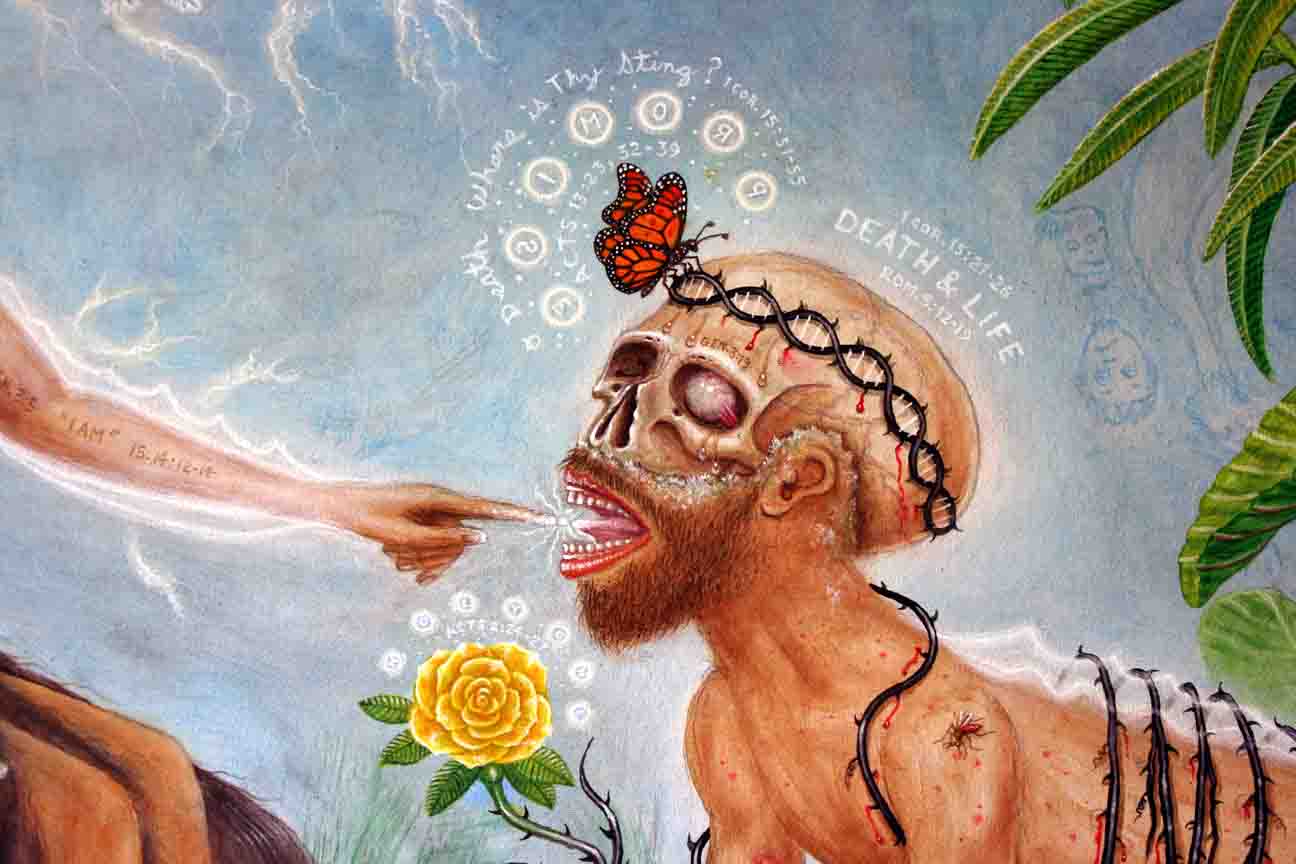
On Adam's forehead engraved into his skull is, GEN. 3:19. This verse reads, "In the sweat of thy face shalt thou eat bread, till thou return unto the ground; for out of it wast thou taken: for dust thou art, and unto dust shalt thou return." There it is, death. Adam was created from the adamah (ground) and he must decompose and turn to dust (aphar, "grey powder, dust or ashes"). Like what is happening to their flesh in the painting. They are decomposing and turning to dust as they flake apart and disintegrate into a grey powder.
Still hope is not gone. Above Adam's head hovers the PROMISE of a Saviour (Acts 13:23, 32-39). "Of this man's seed hath God according to his promise raised unto Israel a Saviour, Yesu...."
"O death, where is thy sting?" (1Corinthians 15:51-55). With the promise of a resurrection and new life, how can death anymore have a sting?
The yellow rose is another symbol of hope and resurrection. Around it are the words HOLY ONE, and the reference, Acts 2:24-27. The holy one is Yesu. Read the reference and see why.
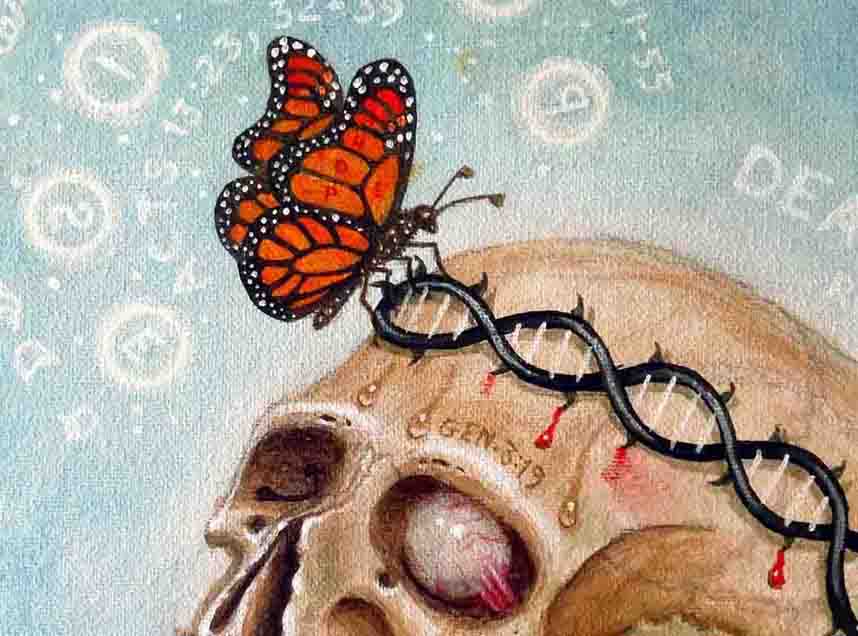
The butterfly is a symbol of resurrection and specifically, the Monarch is a symbol of Yesu Christ. On its wings, lettered in blood, is the word "HOPE," signifying hope in the resurrection and eternal life in joy and happiness. The crown of thorns is connected by the DNA of Christ as the offspring and seed of Abraham. This is the DNA of promise that will be distributed to his followers. The DNA goes from Adam all the way to Christ Yesu and beyond.
Because we are descendants of Adam we all inherit his DNA as well as the suffering and death, but because Yesu is in that same line of DNA, if we are given to him we receive his perfected DNA with the promise that we will be delivered from death and the grave in the future resurrection of glory.
Exhibition List
Apocalypse House
Detail Description Links
Detais: BREAD OF HEAVEN